Why is Earth "Just right"? (Tell me 2 reasons)
-its temperature is not too hot or too cold (This temperature is maintained because Earth has an atmosphere which traps some of the Sun’s energy).
-Earth’s surface is just right for water to be a liquid, which we all need to survive!

What are the 5 major oceans?
**BONUS: TRUE OR FALSE, Oceans spread enormous amounts of energy from the hot equator toward the cold north and south poles.
TRUE
What is WIND?

Wind is the flow of air that occurs as a result of unequal pressure in the atmosphere. Wind flows from an area of high pressure to an area of low pressure.
(PSTT When warm air rises from Earth’s surface, an area of low pressure is created. Eventually the warm air cools and sinks back down creating an area of high pressure)
_____________ are vibrations that travel through Earth and are caused by events like earthquakes or human-made blasts.
**BONUS: a scientist who detects and interprets seismic waves is called a ___________.
Seismic waves
Seismologist.


Earth’s crust is made of different types of rock that are less dense than the mantle.
TRUE Or FALSE: Oceanic crust is less dense than continental crust.
TRUE OR FALSE: Oceanic crust is thinner than continental crust, but both kinds of crust float on the mantle
(1) False, Oceanic crust is made of basalt and is slightly denser than continental crust.
(2) TRUE.
Almost all of the heat energy on Earth’s surface comes from the___________(1). At the same time that the Sun adds heat to Earth's surface, heat is being lost to _________(2).
(1)SUN! (2)SPACE
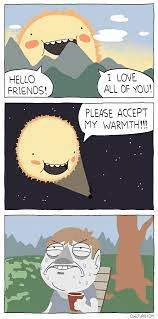
What causes surface ocean currents? (HINT:2 answers)
WIND. wind pushes water and forms patterns called surface ocean currents! (ie. Gulf Stream).
EXPANSION. water at the equator is warm all year because it's directly heated by the sun. warm water = less dense = more space between the molecules = EXPANSION, so water level is higher. gravity allows for the water to flow towards the North and South poles, creating surface ocean currents. 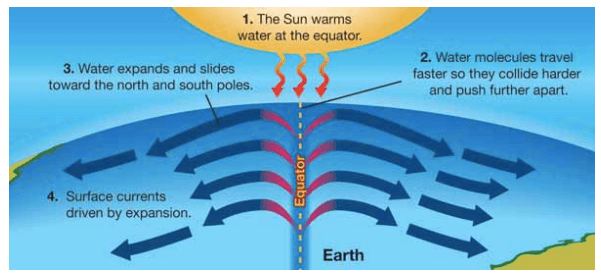
Whats the difference between Climate and Weather?
**BONUS: What is a meteorologist?
Weather can change daily. Climate describes the long-term record of temperature, precipitation (rain or snow), and wind for a region. Climate changes slowly and is nearly the same from one year to the next.
BONUS: A meteorologist is a person with specialized education who uses scientific principles to explain, understand, observe, or forecast Earth’s weather.
There are several types of wave motions. Give me 3 examples!
The “push” or disturbance that traveled down the line of is an example of forward-and-backward wave motion..... THINK DOMINOS
Side-to-side motion can be seen via wiggling a rope.
up-and-down motion can be seen in water waves in a swimming pool!
Why do continents "Float"?
Earth’s crust floats on the mantle just like a boat. Mountains/glaciers weight down on the continental crust, pushing down on the mantle.
Tell me the difference between revolution vs rotation! (give an example!)
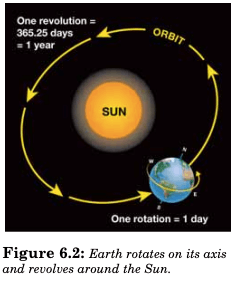
What is another name for DEEP ocean currents?
Deep ocean currents move within the ocean and are slower than the surface currents. Another name for deep ocean currents is thermohaline currents.
Thermo means temperature and haline means salt.
PSTTT they are driven by saltiness and temperature hence the name!!
What is a Thermal vs What is a convection Cell?
A thermal is a small upward flow of warm air. (not stable)
AKA A SMALL CONVECTION CURRENT! 
Convection Cell: large wind
patterns in Earth’s atmosphere
caused by convection. Equator has warmer air, but because of the rotation of Earth, the air cannot go all the way to the poles. 
P-Waves and S-Waves are different types of seismic waves! Which states of matter do they each pass through?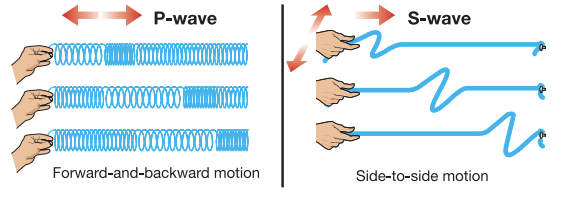
P-waves travel FASTER than S-waves and move with a forward-and-backward motion. Slower S-waves travel with a side-to-side motion. S-waves do not pass through liquids, unlike P-waves which pass through solids, liquids, and gases.
Explain how convection in the lower mantle occurs!
remember, less dense objects FLOAT, and warm air is LESS dense so it RISES.
(PSTT lower mantle
convection drives the lithospheric plates across Earth’s surface so... earthquakes!!)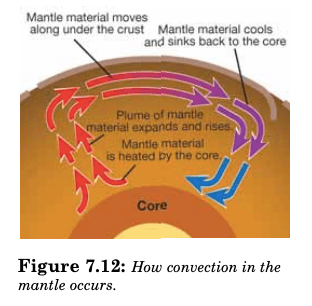
Explain to me how Mercury is TOO hot and TOO cold!
**BONUS: why doesn't Earth get TOO hot or TOO cold?**
 Mercury rotates very slow, while Earth rotates much quicker which is why we don't get the same effect.
Mercury rotates very slow, while Earth rotates much quicker which is why we don't get the same effect.
How do deep ocean currents work?
Water by the equator is warmer, so the water expands, becoming less dense. Through evaporation, water becomes more salty.
As the water flows toward the poles, these currents cool down and the expansion effect is lost. The cooler, saltier water sinks toward the ocean floor—like an underwater waterfall. Deep ocean current water eventually returns toward the surface forming a huge, slow “conveyor belt” of moving water. **VERY SLOW, 1000 of years depending on current
TRUE OR FALSE: (1) warm air can hold more water vapor. (2) Air that contains the maximum amount of water is called saturated. (3) Relative humidity is a measure of how much water vapor an air mass contains relative to the total amount of water vapor it could contain at a certain temperature.
(1) TRUE
(2) TRUE
(3) TRUE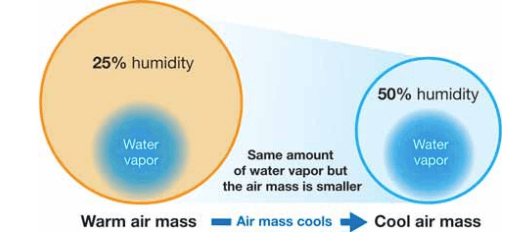
Looking at this map, explain WHY the inner and outer core are not both liquid/ not both solid.
**BONUS: explain what the positives of the outer core are!**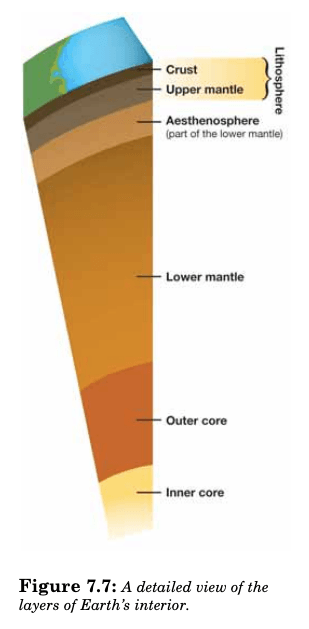
The OUTER core is made mostly of iron, and is so hot the iron is melted. The INNER core is also made mostly of iron, but it is solid because the pressure at the inner core is so enormous that iron, and the rest of the inner core, remains a solid.
BONUS: Powerful electric currents are formed as the liquid outer core moves. These electric currents create Earth’s magnetic field. This magnetic field protects the planet from harmful solar radiation. It also protects the atmosphere. Life on Earth would be in danger if the outer core cooled and stopped moving.

Seismic tomography? What is it ?
Seismic tomography uses seismic waves collected from all over the world to create a three-dimensional image of Earth’s interior (Figure 7.13).
Why does Earth have seasons?
Earth has seasons because it is
tilted on its axis! During our summer, the northern hemisphere
receives sunlight that is more direct than it is in the winter, and in
summer there are more hours of daylight.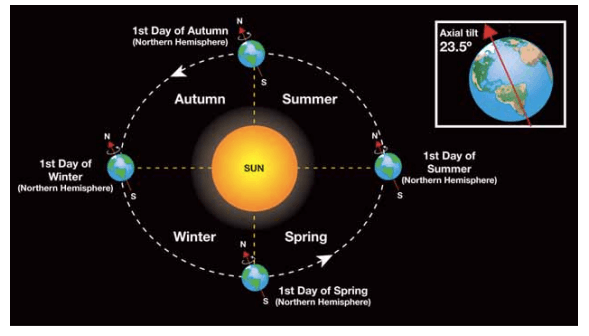
What is the Coriolis effect (natural phenomenon!!) ?
Because of the rotation of Earth, 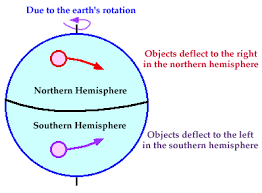
The Coriolis effect allows surface ocean currents to flow in a circular pattern called a GYRE.
Gyres allow for Surface ocean currents to move an enormous amount of heat energy away from the equator, almost EQUALIZING current temperatures in that region
**BONUS: how can one side of a mountain be lush and green and the other side be barren and dry?
Rain forms when water gets evaporated turning into water vapor. The water vapor cools and condenses into tiny droplets called clouds... larger droplets fall as rain! hooray!!
BONUS:
Warm, moist air crosses over the Pacific Ocean and reaches the
coast. At first the air mass flows up the western side of a mountain
which has a lot of trees and plants. Cool temperatures at the top
of the mountain cause the mass to decrease in size so that water
vapor becomes first a cloud and then rain droplets. The resulting
cool, dry air mass sinks down the eastern side of the mountain into
warm temperatures. The land that this dry air passes over will
have a dry climate. 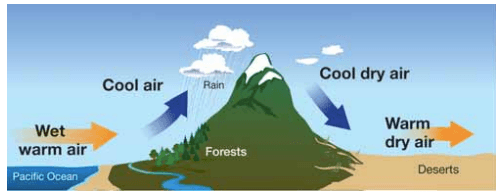
Seeing this table of information, briefly explain the layers of Earth

(Subjective).
Explain how the young Earth separated into layers. Use the term density in your answer.
Once Earth became fluid, materials began to sort out by their densities. Less buoyant, denser materials settled toward the center. More buoyant and less dense materials rose toward the surface. Today aluminum and silicon are common within Earth’s crust. These elements have low densities. The inner and outer cores are composed mostly of dense iron
